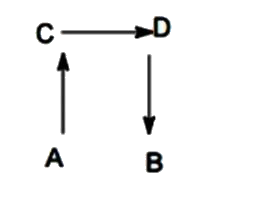A process A→B is difficult to occur directly instead it takes place in the three successive steps.
ΔS(A→C)=50e.u.
ΔS(C→D)=30e.u.
ΔS(B→D)=20e.u. where e.u. is entropy unit. Then the entropy change for the process ΔS(A→B) is:
+100e.u.
−60e.u.
−100e.u.
+60e.u.
The correct Answer is:D
To find the total entropy change for the process from A to B, we can use the given values of entropy changes for the individual steps. The steps are as follows:
1. Identify the given entropy changes:
- ΔS(A to C) = 50 e.u.
- ΔS(C to D) = 30 e.u.
- ΔS(B to D) = 20 e.u.
2. Calculate the total entropy change from A to D:
- The total change in entropy from A to D can be calculated by adding the entropy changes from A to C and C to D:
ΔS(AtoD)=ΔS(AtoC)+ΔS(CtoD)=50e.u.+30e.u.=80e.u.
3. Reverse the process from D to B:
- Since we need to find the change in entropy from A to B, we need to consider the reverse of the process from B to D. The change in entropy for the reverse process is negative:
ΔS(DtoB)=−ΔS(BtoD)=−20e.u.
4. Combine the changes to find ΔS(A to B):
- Now, we can find the total change in entropy from A to B by combining the changes from A to D and D to B:
ΔS(AtoB)=ΔS(AtoD)+ΔS(DtoB)=80e.u.−20e.u.=60e.u.
Thus, the total entropy change for the process from A to B is:
ΔS(AtoB)=60e.u.
- ΔS(A to C) = 50 e.u.
- ΔS(C to D) = 30 e.u.
- ΔS(B to D) = 20 e.u.
- The total change in entropy from A to D can be calculated by adding the entropy changes from A to C and C to D:
ΔS(AtoD)=ΔS(AtoC)+ΔS(CtoD)=50e.u.+30e.u.=80e.u.
- Since we need to find the change in entropy from A to B, we need to consider the reverse of the process from B to D. The change in entropy for the reverse process is negative:
ΔS(DtoB)=−ΔS(BtoD)=−20e.u.
- Now, we can find the total change in entropy from A to B by combining the changes from A to D and D to B:
ΔS(AtoB)=ΔS(AtoD)+ΔS(DtoB)=80e.u.−20e.u.=60e.u.
ΔS(AtoB)=60e.u.
Topper's Solved these Questions
Similar Questions
The direct conversion of A or B is difficult, hence it is carried out by the following shown path
Given, ΔSA→C=50eu, ΔSC→D=30eu,ΔSB→D=20eu

Where eu is entropy unit, then ΔSA→B is .View SolutionThe conversion A to B is carried out by the following path : C→D↑ ↓A B Given : ΔS(A→C)=50 e.u. ,
ΔS(C→D)=30 e.u., ΔS(B→D)=20 e.u.
where e.u. is entropy unit then ΔS(A→B) isView Solution
Knowledge Check
- Question 1 - Select One
a process A→D is difficult to occur directly instead it takes place in three successive steps, ΔS(A→B)=40 e.u., ΔS(B→C)=30 e.u., ΔS(D→C)=20 e.u. where e.u. is entropy unit then the entropy change ΔS for the process (A→D) is
A+ 90 e.u.B+ 50 e.u.C-90 e.u.D- 50 e.u. - Question 2 - Select One
The direct conversion of A to B is difficult. Hence it is carried out by the following shown path:
ΔS(A→C)=50e.u.,ΔS(C→D)=30e.u,
ΔS(B→D)=20e.u where e.u is entropy unit.
Then ΔS(A→B),
A+100e.uB+60e.uC−100e.uD−60e.u - Question 3 - Select One
The direct conversion of A to B is difficult, hence, it is carried out by the following path:

Given:
ΔSA→C=50 c.u,
ΔSC→D=30 c.u.
ΔSB→D=20 c.u where e.u is the entropy unit.
Then, ΔSA→B is:A+60 euB+100 e.uC−60 e.uD100 e.u
The direct conversion of A to B is difficult. Hence it is carried out by the following shown path:
ΔS(A→C)=50e.u.,ΔS(C→D)=30e.u,
ΔS(B→D)=20e.u where e.u is entropy unit.
Then ΔS(A→B),
View SolutionThe direct conversion of A to B is difficult, hence is carried out by the following shown path:
Δ(A→C)=50,ΔS(C→D)=30,ΔS(B→D)=20 The entropy change for the process A→B is :View SolutionThe direct conversion of A to B is difficult, hence it is carried out as
A→C→D→B
Given, ΔS(A→C)=50eU,ΔS(C→D)=30eU,ΔS(B→D)=20eU, where eU is entropy unit. Thus the change in entropy in (A→B) is:View SolutionThe conversion A to B is carried out by the following path : C→D↑ ↓A B Given : ΔS(A→C)=50 e.u. ,
ΔS(C→D)=30 e.u., ΔS(B→D)=20 e.u.
where w.u. is entropy unit then ΔS(A→B) isView SolutionΔH is ΔU for those reactions which take place with increase in volume
View Solution

